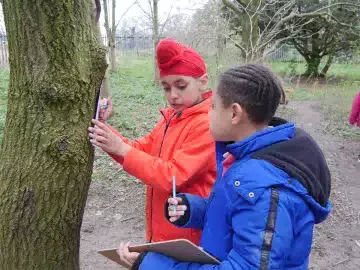
Creative responses to a place
Collecting data and recording information doesn’t have to feel scientific or mathematical, it can also be creative and fun. This activity encourages learners to creatively explore the space around them and take notice of the beauty and diversity to be found. Using the creative prompts resources, learners can respond however they wish to the features and feelings of their site to make their own explorations and observations.
This activity features several different creative prompts for children and young people to choose from, or respond to, as many as they like:
- texture rubbings
- points of view
- onomatopoeia poem
- patterns and shapes
- what colours can you see?
Preparation
What you need
- Creative prompt resources
- Clipboards, one per person
- Pencils, crayons and pens
- Optional: kneeling mats, or tarpaulin or bags to sit on
Location
- Outdoors
Useful guidance
Step by step
- You may want to organise children and young people into small groups so that each person in the group can work on a different prompt, or focus the class on one prompt all together.
- Select an area outside in your site to focus the activity in, ensuring each young person has a creative prompt and pens/pencils to get creative with.
- Begin with a quick grounding exercise to get learners observing their environment. Give your group five seconds to look around at what they can see – give a verbal countdown from 5. Repeat this with what sounds you can hear, and then taking a deep breath in and noticing what you can smell. Ask your learners to share what they saw, heard, felt and smelt with the person next to them.
- Explain the different creative prompts to learners, and that this activity is about your own personal observations and responses to a space – there is no right or wrong! This activity is flexible, allowing you to tailor the time spent depending on the time you have available and the focus of the group.
- Support and check in with learners as they work on their creative responses, in case any are stuck or need refocusing. Remind them to use all of their senses – what can you see? Can you take a closer look? Can you be really quiet and hear something you may not usually be able to hear?
- After 10-20 minutes, regroup and ask learners to share what they created. You could take it in turns depending on what prompt children and young people were working on, and discuss the differences in what was created.
Reflection
Did anything surprise you when exploring this space? Was there anything you noticed that you haven’t before? What could we do to notice more about our learning site? How do you think this could change in a different season?
Curriculum links
This activity can be used to support curriculum knowledge and skill development in english, maths and art, alongside enhancing nature education, with age appropriate adaptations.
What to try next

3D Model making
Begin activity
Points of view
Begin activity